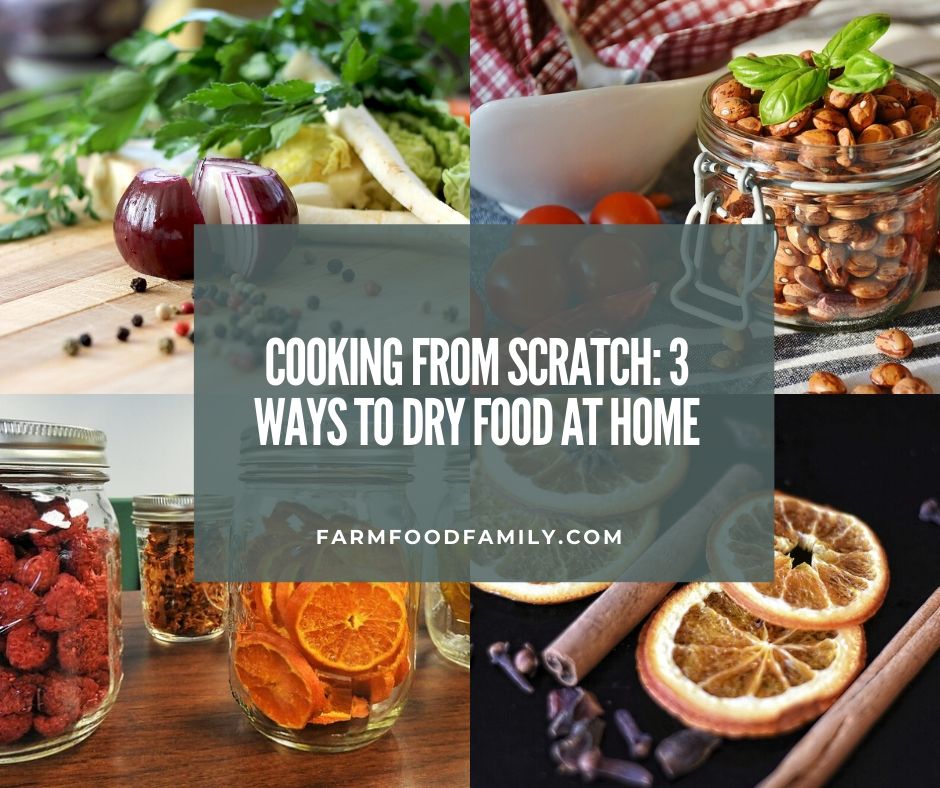Preparing food from scratch means steering clear of pre-made sauces, canned goods, store-bought pasta, or other ready-made ingredients. Put simply, you’ll be pretty much making almost your own food and necessary ingredients.
You’re the one who’s going to produce raisins, beef jerky, and other dry food, too. It’s not that hard to dry your own food at home, though. There are actually many ways to do it, which include sun-drying, oven-drying, and using a food dehydrator.

Sun-drying
Sun-drying is an inexpensive method to dry food. Of course, it’s best to do this during the summer season, specifically when the weather isn’t overly humid, or the temperature is steadily above 29°C or 85°F. Here’s a list of reminders to keep in mind:
- See to it that air can circulate below the food;
- Place aluminum foil beneath the food to reflect the heat; and
- Cover the food with breathable cloth, preferable cheesecloth, to deter insects away.
If you’re not comfortable letting your food sit outside, you can use the heat from the sun trapped inside your car. Place the trays of food that you want to try on your car’s dashboard and close your windows. It may take a couple of days, but be sure that you’re checking them every day so they wouldn’t get too hard.
Oven-drying

If you don’t like going out during a long, dry, and hot summer day, you can still dry your meat, herbs, fruits, and vegetables indoors as long as you have an oven. Simply spread your food on wire racks, trays, or directly over the oven racks and set your oven to the lowest temperature.
Conventional ovens are typically steady and reliable for drying foods. However, it requires a lot of work. You have to turn each food as often as possible. It takes a few hours to turn each side of beef jerky slices, too.
For fruits and vegetables, turn each side every after 20-30 minutes. Thinly sliced apples can be completely dry and turn to chips after baking at 107° C or 225° F for two hours. But if this is quite inconvenient for you, you can dry fruit slices in your toaster oven. The thing is, you can have to dry them in small batches. If this method is time-consuming for you, consider the next one.
Food Dehydrator

Food dehydrators can be pre-programmed. It completely dries any food even if you would leave it unattended. What’s more, they’re digitized. You can keep track of the temperature, humidity, and drying time.
You also have to use pre-treatment for different food you’d like to dry. If you plainly dry fruits or vegetables in your dehydrator, these dried foods may end up getting very chewy and unpalatable to eat as a treat.
When dehydrating foods, some need to be pre-treated to taste and look better and last longer. There’s no need to opt for fancy ingredients when home drying. Again, we’re cooking everything from scratch. For example, here are some alternatives you can use when preparing for the pre-treatments:
- Apples – There are two ways: (1) Steam within 3-4 minutes or (2) Soak them in a mixture of ¼ cup citrus juice (lime, lemon or pineapple) and a cup of water
- Bananas – Soak them with citrus juice
- Strawberries – Steam for a minute
When you want to make fruit leathers, which are also referred to as fruit rolls, you need a food processor – check out these top picks – and other kitchen utensils. This is typically done if you have on-its-way-out fruits. The fruit roll preparation is generally easier than preserving fruits. Here are a few quick steps that you should follow:
- Thoroughly wash, hull, and slice the fruits
- Toss them in the blender/food processor
- Pour the puree onto a parchment paper or dehydrator sheet
- Set your food dehydrator at 57° C or 135° F for 4-12 hours
Finally, a food dehydrator is costly, but it doesn’t take too much time, unlike drying food under the sun or in the oven. Buying it is a worthwhile investment if and only if you’re planning to do a lot of food drying. But, if you’re just making an occasional dried treat, you can perhaps borrow a dehydrator from your friend or do the sun or oven-drying, instead.
Takeaway
While you’re going to produce most of your ingredients when preparing your food, you still have to go to the market for some necessities. In your grocery list, there will be fewer or better yet no convenient/junk goods enlisted, though. You have to buy fresh food, like fruits, vegetables, herbs, meat and eggs, and other condiments.
More importantly, whether you’re health-restricted (people with diabetes, hypertensive, allergic, etc.), environmentally-friendly (vegan or vegetarian), or just a simple health-conscious person, you have to consider the ingredients of the grocery items you are buying or bringing home.

